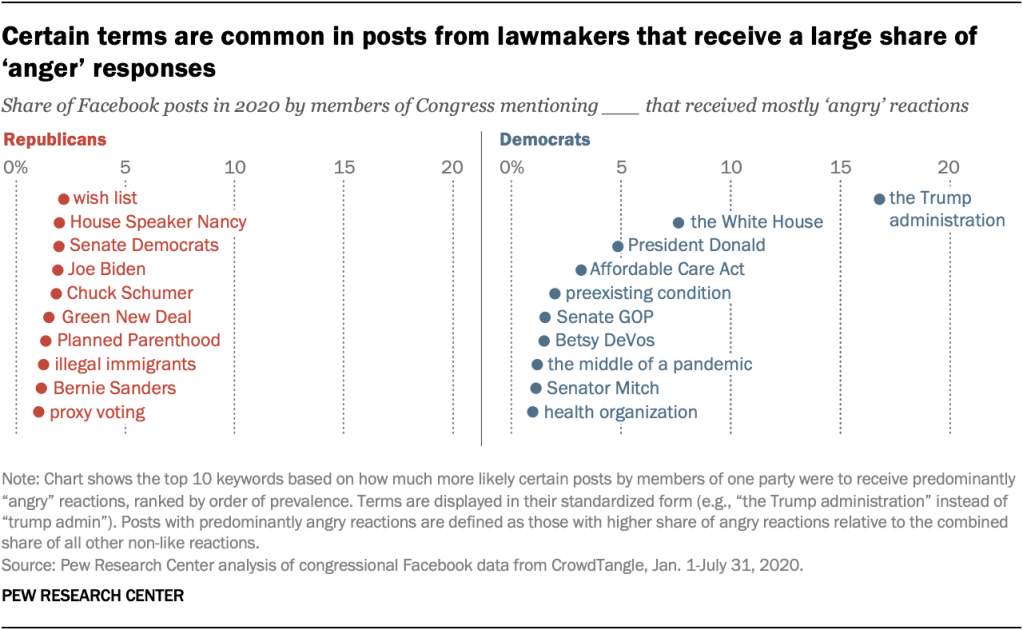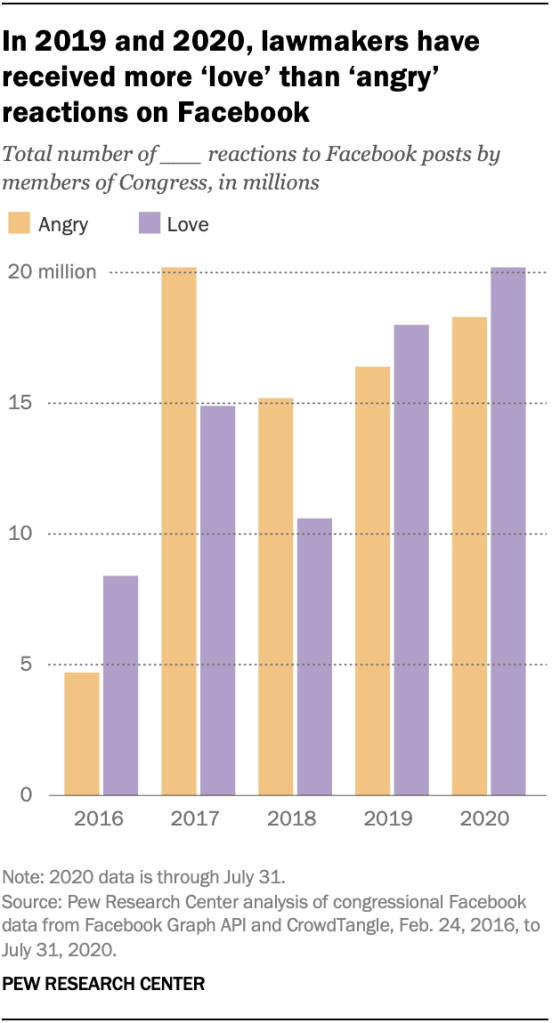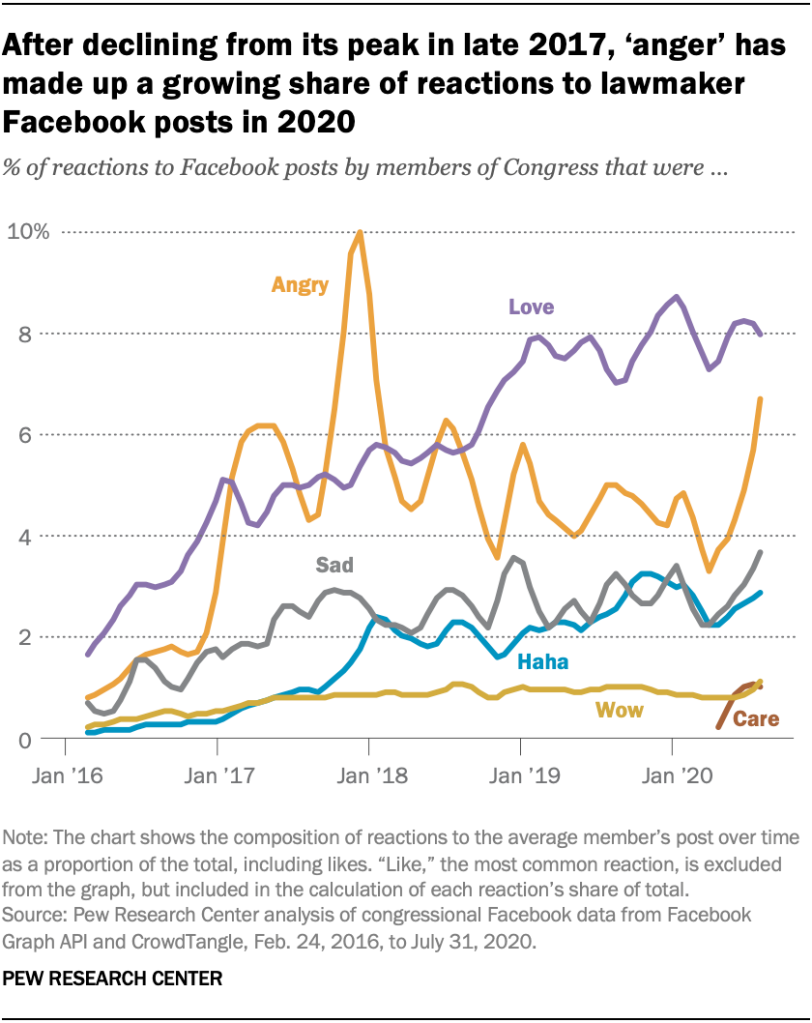In the wake of the 2016 presidential campaign, Facebook users were more likely to press the “anger” button than the “love” button in response to lawmakers’ posts on the platform. But a new Pew Research Center analysis finds that this trend has shifted in recent years, and that lawmakers received more love than anger reactions to their posts in 2019 and 2020.
Facebook users can respond to posts on the site with a set of “reaction” emojis such as “love,” “angry” or “sad” as an alternative to the typical “like” button.
In both 2017 and 2018, Facebook posts by members of Congress received around 5 million more “angry” reactions than “love” reactions. But love reactions overtook anger in 2019, and lawmakers have received roughly 2 million more love than anger reactions in the first seven months of 2020.
The total number of reactions (of any type) to congressional Facebook posts has dramatically increased recently. In just the first seven months of 2020, lawmakers have received more love and angry reactions combined than in any of the four previous full calendar years. But the growing popularity of love reactions is also apparent when examining the share of emotional reactions and “likes” that individual posts received.
Facebook users can respond to posts on the site with a set of “reaction” emojis such as “love,” “angry” or “sad” as an alternative to the typical “like” button. This analysis examines reactions by the Facebook audience to posts on the platform from members of Congress. To analyze reactions to congressional posts, researchers studied a complete set of posts created by members of the U.S. Senate and House of Representatives, dating back to the introduction of Facebook reactions in February 2016. The resulting dataset contains nearly 1.3 million Facebook posts from 1,385 congressional Facebook accounts owned by 711 members of Congress.
Researchers also identified individual posts that received a largely angry response from Facebook users, and identified terms that are unique or distinctive to these posts. Largely angry posts are those for which the share of “angry” reactions exceeds the combined share of all other non-like reactions. The methodology for this analysis can be found here.
By this metric, “love” has consistently increased its share of reactions to lawmaker posts since reactions were introduced in early 2016. For the month of July 2020, “love” comprised roughly 8% of reactions to these posts while “anger” made up roughly 6%. “Love” surpassed “anger” as the most common reaction by share (not counting the more generic “like” button, which accounts for roughly three-quarters of all reactions) starting in late 2018 and has maintained that distinction ever since.
In contrast to the steady and consistent increase of the use of the “love” reaction, the share of “angry” reactions to lawmaker posts has fluctuated over time. There have been several notable spikes in the share of angry reactions to lawmaker posts, such as in the months after the 2016 election and again in late 2017.
More recently, there has been another uptick in the share of angry reactions in the spring and summer of 2020 – a period that included events such as the COVID-19 outbreak and protests against police violence in many U.S. cities following the killing of George Floyd by police. From March to July of this year, the share of angry reactions to lawmaker posts has doubled, from 3% to 6%. And lawmakers from both major parties have seen an increase in the share of angry reactions to their posts in recent months.
Beyond love and anger, the other Facebook reactions (“sad,” “haha,” “wow” and the recently added “care”) make up a small but increasing share of reactions to lawmaker posts.
For each party, certain terms appear frequently in posts that draw strongly angry reactions
In the first seven months of 2020, around 14,000 posts from Democratic lawmakers and 10,000 posts from Republicans produced a largely angry reaction from the Facebook audience. These largely angry posts are defined as those that received more angry reactions than the other five major reactions combined, not including likes. And for each party, certain terms tend to be more prevalent in posts that elicit a strongly angry reaction than in posts that do not.
Posts from Democratic members that received a strongly angry reaction often directly mentioned the current president and administration. “The Trump administration” – used in 17% of posts from Democratic lawmakers that drew a largely angry response – is one such phrase. Other relatively common terms in posts from Democratic lawmakers that induced an angry reaction include “the White House” (used in 8% of such posts), as well as policy-specific terms like “Affordable Care Act” (3%).
For Republican lawmakers, no single term stands out to a similar extent. Terms such as “Green New Deal” and “[liberal] wish list” made up an outsize share of posts from Republicans that received a largely angry response, but each of these terms was mentioned in 2% or fewer of such posts.

Note: Here is the methodology for this report.


